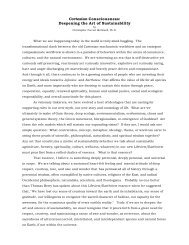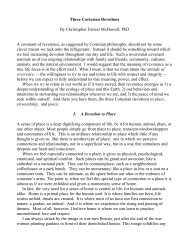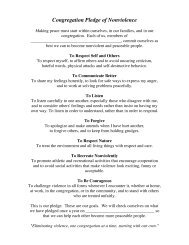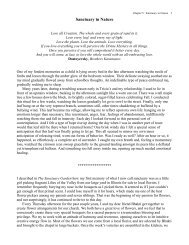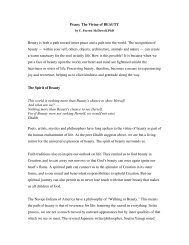Wellness: A New Map of Service
Wellness: A New Map of Service
Wellness: A New Map of Service
- No tags were found...
Create successful ePaper yourself
Turn your PDF publications into a flip-book with our unique Google optimized e-Paper software.
also positive and optimistic/receptive, the perceptions you have about body, mind, and sensate matterbecome more positive and appreciative as well.Now, let's consider that at any point on the wellness/worseness continuum you begin a leftwardmovement. The inference here is segmentation and disintegration <strong>of</strong> your potential for wholeness.Therefore, your objective conscious will becomes more identified with any host <strong>of</strong> bodily, mental, orother sensate worldly experiences and thoughts. In a sense you close yourself <strong>of</strong>f from the heart <strong>of</strong>yours and perhaps others' feelings, wisdom, and sense <strong>of</strong> spirit, which are just as critical in attempting torelate to life.As I suggested earlier, during the course <strong>of</strong> a day we fluctuate in our leftward and rightwardmovements. This fluctuation is a natural outcome <strong>of</strong> the way our bodymindspirit life force is living atany given moment in response to a particular environment and its accompanying stimuli. We could callthis present-moment states <strong>of</strong> wellness. However, it might also be said that we display a broaderorientation toward wellness, one which embraces our overall lifestyle attributes.When a person's life force and lifestyle energy basically pulls them into a preoccupation withnegative body or mind states (as practitioners we can attest this to be the case with most <strong>of</strong> our clients), ahost <strong>of</strong> disintegrative characteristics describe their wellness cosmology. As you can see in the diagram,these characteristics are quite familiar and broad. We can sense an imbalance occurring, a degree <strong>of</strong>being closed <strong>of</strong>f from others. One may also perceive rigidity in thinking, even an expression <strong>of</strong> apathyand stagnancy. Often, thinking may appear to be sex-typed, stereotyped, egocentric. Finally, there maybe a strong sense <strong>of</strong> victimization accompanied by thoughts <strong>of</strong> helplessness and hopelessness. Usingterms familiar to the practitioner, a focusing <strong>of</strong> energy towards illness/worseness results in dysfunctionalbehaviors, minimal spontaneity, focus on symptoms, trouble adapting, negative addictions, acting out,loneliness, giving up, and fear, among others.<strong>Wellness</strong> practitioners identify the above disintegrative conditions as indicative <strong>of</strong> a pathologicallifestyle. This style <strong>of</strong> life may very well describe many people, for it permeates to some degree thewellness determinants. For examples, just consider the many people who experience excess stress ormental depression, low physical fitness, lack <strong>of</strong> conscientious nutritional habits, little sensitivity for thewell-being <strong>of</strong> nature and other social/cultural environments and species, dysfunctional familialrelationships, leisure dis-satisfaction and illiteracy, educational and vocational dispondency, and so on.Can it be questioned in any way that a strong lifestyle leaning toward a worldly preoccupation <strong>of</strong> bodily,mental, and material concerns is clearly a fascination with pathos? And furthermore, that a whole healthcare system (more accurately illness care) and a similarly potent marketing and media pursuasionindustry have contrived to keep people actively involved in such a pathological fascination?



